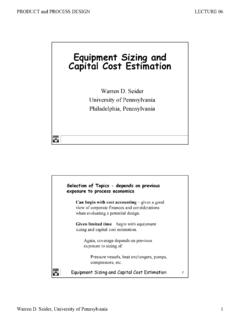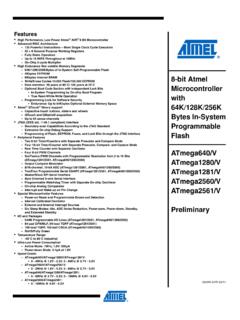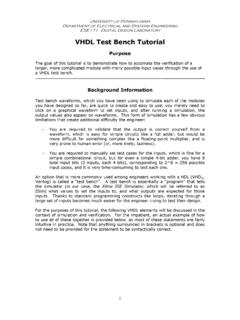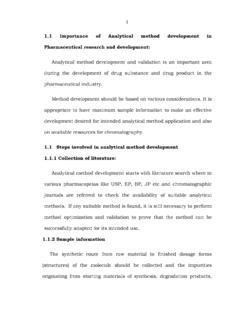Transcription of Geochemical Prospecting - Penn Engineering - …
1 Earth Science: Geochemistry Engineering & Materials: Other Engineering Disciplines:Mining Engineering Geochemical Prospecting he use of chemical properties of naturally occurring substances (including rocks, glacial debris, soils, stream sediments, waters, vegetation, and air) as aids in a search for economic deposits of metallic minerals or hydrocarbons. In exploration programs, Geochemical techniques are generally integrated with geological and geophysical surveys. See also: Geophysical exploration History Many fundamental principles of geology and chemistry were known in antiquity, and references to the use of chemistry in the search for mineral deposits are not infrequent in both classical and Renaissance literature. The techniques of modern Geochemical Prospecting originated in the Soviet Union and Scandinavia, where extensive research into methodology was conducted during the 1930s.
2 After World War II these techniques spread to the western world and were further developed; by 1960 they had become widely used by both government agencies and mining companies. By 1970 geochemistry had become firmly established as one of the most effective tools of mineral exploration. Several factors contributed to the rapid development of Geochemical Prospecting during the twentieth century. It was found that most metallic mineral deposits are surrounded by halos of abnormal trace-element concentrations in the adjacent and enclosing rocks. Also, abnormal trace-element concentrations in materials such as glacial sediment, soil, spring or stream water, and stream sediment were recognized as being derived from the weathering of mineral deposits. Precise and rapid methods of chemical analysis suitable for the detection of low concentrations (a few parts per million, or even parts per billion) of elements and compounds in natural media were developed.
3 These methods include use of the emission spectrograph, specific and sensitive colorimetric reagents, atomic absorption spectrometry, and development of polyethylene laboratory equipment. The effectiveness of Geochemical exploration has been greatly enhanced by the use of computer-aided statistical techniques for processing and evaluation of data. Sampling techniques have become steadily more effective with the use of helicopters and devices such as overburden drills. Understanding of the significance of landscape in Geochemical exploration has progressed considerably, permitting the most effective set of field techniques and interpretive procedures to be selected for any given set of field conditions. Geochemical Prospecting is employed extensively in all regions of the world from the Arctic to the tropics, and has contributed significantly to the success of many important mineral exploration programs.
4 New technologies promising further advances include the use of plasma spectrography and of airborne particulate matter as a sample medium. See also: Analytical chemistry; Chromatography General Principles Mineral deposits represent anomalous concentrations of specific elements, usually within a relatively confined volume of the Earth's crust. Most mineral deposits include a central zone, or core, in which the valuable elements or minerals are concentrated, often in percentage quantities, to a degree sufficient to permit economic exploitation. The valuable elements surrounding this core generally decrease in concentration until they reach levels, measured in parts per million (ppm) or parts per billion (ppb), which appreciably exceed the normal background level of the enclosing rocks. This zone surrounding the core deposit is known as a primary halo or anomaly, and it represents the distribution patterns of elements which formed as a result of primary dispersion.
5 In general, it is formed at, or near, the same time as the central ore body. Mineral deposits at, or near, the surface are subject to chemical and physical agencies of weathering. Many of the ore minerals undergo decomposition or disintegration, and their chemical constituents become dispersed into weathering debris, soils, ground water, and plant tissue. Further dispersion, often over considerable distances, may ensue due to the agencies of glaciers or stream and river systems. Abnormal chemical concentrations in weathering products are known as secondary dispersion halos or anomalies and are more widespread. All of these halos afford means whereby mineral deposits can be detected and traced; they form the Geochemical anomalies which are the objects of search of all Geochemical prospectors. See also: Ore and mineral deposits Primary environment Most igneous rocks have formed by a differentiation process.
6 This starts with a parent magma, often of basaltic composition, and as cooling proceeds, early-crystallizing minerals are separated to form cumulate rocks. The remaining melt, having lost elements that are concentrated in the early minerals, becomes changed in composition. Through such a process the magma may pass through a differentiation series, such as gabbro-diorite-granodiorite-granite-pegm atite, in which each point has a distinctive composition of both major and minor chemical elements. In general, as differentiation proceeds, there is an overall decrease in iron, magnesium, calcium, and titanium in the rocks combined with an increase in silicon, aluminum, sodium, and potassium. Trace-element concentrations also change considerably with this sequence of rock type and major element alteration. The occurrence of trace elements in rock-forming minerals is generally controlled by a combination of ionic size, valency, and type of chemical bond.
7 Some elements, however, including lithium (Li), boron (B), beryllium (Be), niobium (Nb), tantalum (Ta), tin (Sn), uranium (U), thorium (Th), tungsten (W), zircon (Zr), and the rare earths, do not enter rock-forming silicate minerals to any significant degree during magmatic crystallization. These elements tend to be concentrated in residual aqueous fluids together with compounds such as hydrogen fluoride (HF), hydrogen chloride (HCl), and carbon dioxide (CO2), and remain in solution until the final stages of magma crystallization, exemplifying primary mobility. They eventually may become concentrated in pegmatites, and may play an important role in hydrothermal alteration and ore formation. Primary dispersion halos vary greatly in size and shape as a result of the numerous physical and chemical variables that affect fluid movements in rocks. Some halos can be detected at distances of hundreds of meters from their related ore bodies; others are no more than a few centimeters in width.
8 Some of the factors controlling the development of primary halos are presence or absence of fractures in the host rock, porosity and permeability of the host rock, tendency of mineralizing fluids to react chemically with the host rock, and volatility of the ore elements. The main types of primary halos are syngenetic and epigenetic. Syngenetic primary halos are formed essentially contemporaneously with the enclosing rocks. Epigenetic primary halos are formed after the host rock has solidified, and result from the introduction of mineralizing solutions to open spaces such as fractures. Epigenetic primary halos may cover large areal extents, as when a rock mass is pervasively altered by hydrothermal solutions, or they may be restricted to well-defined channelways through which mineralizing fluids have followed open spaces such as fractures or solution channels.
9 They are frequently developed in rocks overlying an ore body and can be of great value in Prospecting (Fig. 1). Volatile elements, such as mercury and radon, offer the greatest possibilities for successful ore discovery utilizing leakage dispersion, because they move farther than other elements. Fig. 1 Cross section showing use of surface rock chip sampling to detect leakage anomalies that reflect concealed zinc mineralization. Horizontal distance is 1 km ( mi), vertical distance, 200 m (650 ft). Ore bodies have formed in a porous limestone bed capped by an impermeable shale; some mineralizing fluid has escaped upward along preexisting faults. Many elements occur in hydrothermal mineralizing solutions, and some may be more mobile than others. In some cases, however, the element yielding the most extensive primary dispersion halo is not that of greatest economic significance in the ore body, even though it is closely associated geochemically.
10 Such an element is referred to as a pathfinder, and is of value in Prospecting because its halo is broader than that of the element of primary interest or because it may be detected more readily by conventional analytical procedures. Arsenic is frequently used as a pathfinder element in Geochemical exploration for gold; radon is frequently utilized in similar manner in uranium exploration. Secondary environment Most samples analyzed are materials from the secondary environment, making it particularly important in Geochemical exploration. Rocks and minerals that are stable in the primary environment are frequently unstable in the secondary; they undergo disintegration and modification through a variety of chemical and physical processes that are known collectively as weathering. Trace elements of ore bodies and their associated primary halos are frequently released by weathering processes to soils, overburden, and vegetation, with consequent generation of secondary halos.










